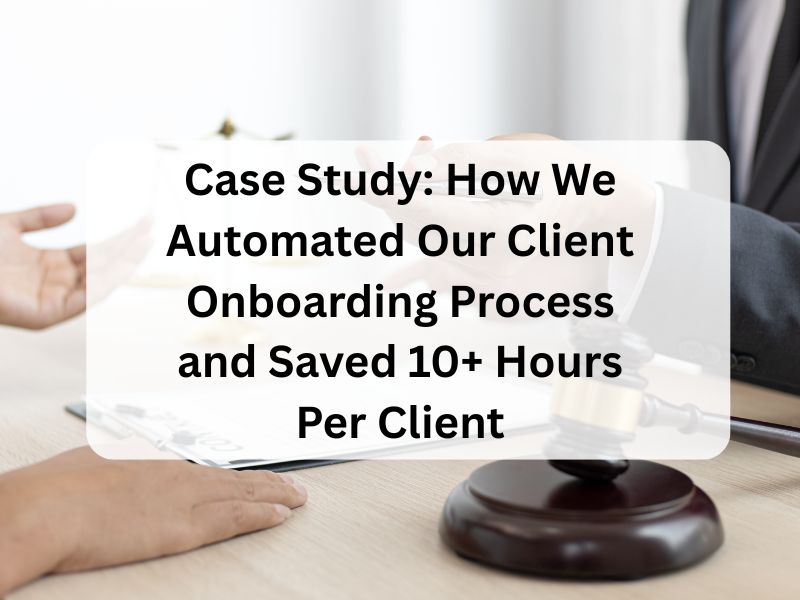When our client onboarding process started to feel like a full-time job, we knew it was time to make a change.
Between manual emails, repeated Slack invites, Notion setup, and follow-ups—we were spending 10 to 15 hours onboarding each client. That doesn’t scale.
So, we built an automated onboarding system using Make , integrated with tools like Stripe, Notion, Slack, Google Workspace, and even Loom.
The result?
✅ Fully automated onboarding
✅ 80% reduction in manual work
✅ Happier clients, faster starts
Here’s exactly how we did it—step by step.
🔍 The Problem
Before automation, our onboarding looked like this:
- Stripe payment came in
- We manually sent a welcome email
- Created a new client Notion page from a template
- Created a Slack channel
- Sent calendar booking links
- Manually followed up if they didn’t respond
It was inconsistent and exhausting—and if we forgot one step, the client experience suffered.
🎯 The Goal
We wanted an onboarding process that was:
- 100% automated after payment or contract signing
- Personalized for each client
- Fast, professional, and consistent
- Easy to tweak and scale
🧰 The Tools We Used
Here’s the stack we connected in Make:
| Tool | Purpose |
|---|---|
| Stripe | Payment trigger |
| Google Sheets | Store client data |
| Notion | Project management & templates |
| Slack | Create private client channels |
| Gmail | Send emails |
| Loom | Auto-generate personalized welcome video |
| Calendly | Send booking links |
| Make | Automate everything |
⚙️ Step-by-Step Setup
Step 1: Detect New Client Payment in Stripe
We set up a webhook in Make to watch for a successful payment event in Stripe.
When a new client pays, the following data gets pulled:
- Name
- Package purchased
- Company
This kicks off the onboarding flow.
Step 2: Store Client Info in Google Sheets
Each new Stripe customer is added to a Google Sheet as a log:
- Date of payment
- Full name
- Slack Channel Name (auto-generated)
- Status (e.g., “Onboarding Started”)
This gives us a simple dashboard of all active clients.
Step 3: Create a Client Workspace in Notion
Next, Make triggers Notion to duplicate a pre-built template, rename it with the client’s name, and insert project-specific data.
The template includes:
- Welcome message
- Project timeline
- Deliverables
- Communication channels
- FAQs
🎯 No more copy-pasting or forgetting documents!
Step 4: Generate a Slack Channel
We connected Slack’s API to automatically:
- Create a private channel (e.g.,
#client-xyz) - Invite our internal team
- Send a welcome message to the channel with next steps
You can even add the client if your Slack Connect is set up.
Step 5: Send a Personalized Email With Everything They Need
Using Gmail + dynamic fields from the Stripe and Notion steps, we send a warm, personalized welcome email that includes:
- Their Slack channel link
- Link to their Notion dashboard
- Booking link for their kickoff call (Calendly)
- Optional: A Loom intro video link personalized with their name
💡 Pro Tip: You can pre-record generic Loom videos and just swap the name in the text to fake personalization at scale.
Step 6: Auto-Follow-Up If They Don’t Respond
We added a delay step in Make that checks:
- If the client hasn’t scheduled a kickoff call within 48 hours
If no booking is found, we auto-send a gentle follow-up email to nudge them.
🔄 Optional Add-Ons
You can easily extend the system to:
- Add the client to ClickUp, Asana, or Trello
- Send SMS via Twilio
- Trigger Zapier webhooks if you’re using hybrid automations
- Add the client to an email onboarding sequence (ConvertKit, ActiveCampaign)
📊 The Results
In the first 30 days after launching the system:
| Metric | Before | After |
|---|---|---|
| Onboarding Time | 10–15 hrs | 1–2 hrs |
| Human Errors | Frequent | Zero |
| Client Feedback | “Okay” | “So smooth!” |
| Follow-Up Rates | ~40% booked kickoff | 90%+ booked kickoff |
We’re now onboarding 3x more clients with the same team—and our customer satisfaction has never been higher.
🧠 Lessons Learned
- Consistency builds trust. A reliable onboarding flow impresses clients right out of the gate.
- Personalization is scalable. With dynamic fields and AI tools, you can make automation feel human.
- Automation isn’t just for big teams. Solopreneurs and small agencies benefit the most—freeing up time to actually do the work.
✅ Final Thoughts
Automating client onboarding was one of the best things we ever did.
It didn’t just save time—it raised our perceived value, made our clients feel special, and let us focus on results instead of logistics.

